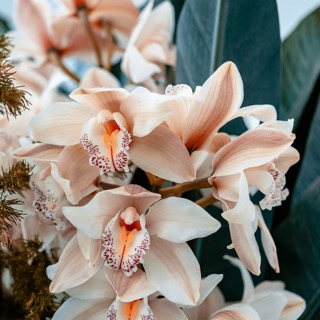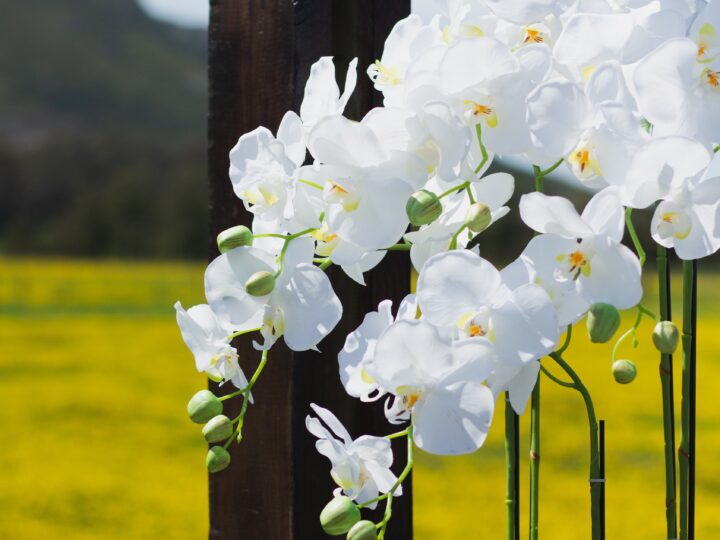Orchids are a fascinating and diverse group of plants that have been revered for their beauty and elegance for thousands of years. With over 25,000 species and hundreds of thousands of hybrids, orchids are one of the largest plant families in the world. These plants are prized for their delicate and often fragrant blooms, which can range in colour from pure white to vibrant reds, purples, and pinks.
Orchids can be grown both indoors and outdoors, depending on the specific species and the climate in which they are grown. They are relatively easy to care for, with a few key requirements for light, water, and nutrients. With proper care, orchids can bloom for several months at a time, making them an attractive and low-maintenance addition to any home or garden.

Despite their reputation for being fussy, orchids are very resilient and adaptable plants that can thrive in a wide range of conditions. With a little bit of knowledge and effort, anyone can successfully grow and care for orchids. Whether you’re an experienced gardener or a newcomer to the world of plants, orchids are a beautiful and rewarding addition to any collection. Orchids are beautiful and exotic plants that require special care to thrive.
Table of Contents
Are orchids better as indoor plants or as outdoor plants?
Orchids can be grown both indoors and outdoors, depending on the specific species and the climate in which they are grown. Here’s a general comparison between indoor and outdoor orchids:
Indoor Orchids
Indoor orchids are typically tropical or subtropical plants that need warm, stable temperatures and bright, indirect light to grow. Indoor orchids are well-suited to growers who have limited outdoor space or who live in areas with harsh climates. They are relatively easy to care for, as they are protected from environmental stressors such as wind, rain, and temperature fluctuations. Indoor orchids typically bloom for several months at a time and can be re-bloomed with proper care.
Outdoor Orchids
Outdoor orchids are typically hardy plants that can withstand a range of environmental conditions. Outdoor orchids are well-suited to growers who live in warm, humid climates with well-drained soil and bright, filtered light. Outdoor orchids can be more challenging to care for than indoor orchids, as they are exposed to environmental stressors such as wind, rain, and temperature fluctuations. They typically bloom once a year and can form large, spectacular displays of flowers.

Ultimately, whether orchids are better as indoor or outdoor plants depends on the specific species and the grower’s circumstances. Some orchids can be grown successfully both indoors and outdoors, while others are better suited to one environment or the other. If you’re unsure which type of orchid is right for you, consider consulting with a local nursery or an expert.
How to take care of your orchids:
Light
Orchids need bright, indirect light to grow. Place them near a window with filtered light or under a sheer curtain. Avoid direct sunlight, which can scorch the leaves.
Water
Orchids are sensitive to over-watering, which can cause root rot. Allow the potting mix to dry out between waterings and then water thoroughly. Water less frequently in the winter and more often in the summer.
Temperature
Most orchids prefer warm temperatures, around 70-85°F (21-29°C). Nighttime temperatures should be slightly cooler. Avoid sudden temperature changes and drafty areas.
Humidity
Orchids like a humidity level of 50-70%. You can increase humidity around your orchid by placing a tray of water near the plant or using a humidifier.
Fertiliser
Fertilise your orchid every two weeks with a balanced water-soluble fertilizer, diluting it to half the recommended strength. Avoid fertilising during the winter.
Potting Mix
Orchids need a well-draining potting mix. You can purchase a specialised orchid potting mix or make your own by combining bark, perlite, and sphagnum moss
Re-Potting
Orchids need to be re-potted every 1-2 years or when the potting mix has broken down and is no longer providing proper support. Use a pot that is only slightly larger than the previous one and gently remove the old potting mix.
How do I fertilise orchids?
Fertilising orchids is an important part of their care to ensure they receive the necessary nutrients for healthy growth and blooming. Use a balanced, water-soluble fertiliser specifically formulated for orchids. Avoid using fertilisers that are high in nitrogen, as this can encourage leaf growth at the expense of flowers.
Dilute the fertiliser to half the recommended strength. This will help prevent fertiliser burn, which can occur if the concentration is too high. Fertilise your orchids every 2 weeks during the growing season (spring to fall), but avoid fertilising in the winter when the plants are in a dormant phase.
Water your orchids as usual, and then apply the diluted fertiliser solution to the potting mix, being careful to avoid getting fertiliser on the leaves or in the centre of the plant. After fertilising, be sure to flush the potting mix with clear water to remove any excess fertiliser, which can build up over time and become toxic to the plant.
By following these steps, you can help provide your orchids with the proper nutrition they need to thrive. If you’re not sure how much fertiliser to use, always consult the manufacturer’s instructions for the specific product you’re using.

How do I get rid of the yellow leaves on orchids?
Yellow leaves on orchids can indicate several issues, including over-watering, under-watering, low light, or nutrient deficiencies. Here’s what you can do to get rid of yellow leaves on your orchids:
- Over-Watering: If the yellow leaves are accompanied by mushy or soft leaves, your orchid is probably being over-watered. Allow the potting mix to dry out completely between waterings, and reduce the frequency of watering.
- Under-Watering: If the yellow leaves are dry and crisp, your orchid is likely being under-watered. Increase the frequency of watering, making sure to water thoroughly so that the potting mix is evenly moist.
- Nutrient Deficiencies: If the yellow leaves are accompanied by stunted growth or a lack of blooms, your orchid may be suffering from a nutrient deficiency. Fertilize your orchid with a balanced water-soluble fertilizer, making sure to dilute it to half the recommended strength.
If the yellow leaves are not accompanied by any other symptoms, it is normal for orchids to shed older leaves as they grow new ones. Simply remove the yellow leaves by cutting them off at the base of the plant.
By addressing these issues, you can help your orchids recover and get rid of yellow leaves. If you’re unsure what’s causing the yellowing leaves, consider consulting with a local nursery or an expert.
Pest control for orchids
Orchids, like all plants, can be susceptible to pest infestations. Here are some common pests that can affect orchids and how to control them:
- Mealybugs: Mealybugs are small, cottony insects that feed on plant sap. They can be controlled by wiping them off with a cotton swab dipped in rubbing alcohol, or by using insecticidal soap.
- Spider Mites: Spider mites are tiny spider-like pests that can cause yellowing and stunted growth. They can be controlled by blasting the leaves with a strong stream of water, or by using a pesticide specifically formulated for spider mites.
- Scale insects: Scale insects are small, flat, armoured pests that feed on plant sap. They can be controlled by wiping them off with a cotton swab dipped in rubbing alcohol, or by using insecticidal soap.
- Thrips: Thrips are tiny, slender insects that feed on plant sap and can cause damage to flower buds and leaves. They can be controlled by using a pesticide specifically formulated for thrips.
- Slugs and Snails: Slugs and snails can cause damage to orchid leaves and flowers. They can be controlled by removing them by hand, by using slug and snail bait, or by creating a physical barrier around the base of the plant.
It’s important to take swift action when you notice a pest problem, as pests can reproduce quickly and cause significant damage to your orchids. If you’re not sure what type of pest is affecting your orchids, consider consulting with a local nursery or an expert. In addition, always follow the instructions on any pesticides you use, and take care to avoid exposing yourself or other non-target species to the chemicals.
Conclusion
In conclusion, orchids are beautiful and diverse plants that can bring a touch of nature to any home or garden. By providing proper care and attention, including the right amount of light, water, and nutrients, you can help your orchids thrive and enjoy their long-lasting blooms. Regular monitoring for pests and diseases, and taking appropriate action when necessary, can also help keep your orchids healthy and beautiful. With a little bit of effort, orchids can be a rewarding and low-maintenance addition to your indoor or outdoor environment.
